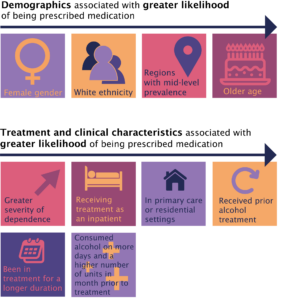
People recovering from an addiction to alcohol are vulnerable to relapse in the period after receiving treatment. Recent data in England show over 60% of people return to drinking in the first 6 months. There are three safe and effective medications to help support people in recovery, these are acamprosate (Campral), naltrexone and disulfiram (Antabuse). It is recommended that they are used with psychological therapy as an additional treatment to help prevent relapse. Despite the potential for these medications to help people in recovery from alcohol addiction, they are not being used routinely in clinical practice in England. I wanted to look at the rates of prescribing of these medications in alcohol treatment services more closely to understand who is and who is not being prescribed them.
What are the rates of prescribing?
The National Drug Monitoring Treatment System (NDTMS) is a reporting system of service users who receive specialist drug and alcohol treatment in England. I looked at data from 188,152 people who received treatment for their alcohol use in the years 2013 – 2016, to estimate how many people were prescribed one of the three alcohol relapse prevention medications.
Only 2.1% of service users received these medications in the year 2013/14, 6.8% in 2014/15 and 7.8% in 2015/16.
Who is more likely to be prescribed these medications?
Some demographic characteristics were associated with a greater likelihood of being prescribed these medications. I also found certain treatment and clinical characteristics that were associated with being prescribed acamprosate, naltrexone or disulfiram, summarised in the graphic below.

What do the findings mean?
The NDTMS represents prescribing taking place in specialist alcohol services. Specialist alcohol services are usually responsible for initiating the prescribing of these medications, with prescriptions continued by a GP. Therefore, the rates of prescribing found in this research are a good estimation of prescribing rates in England.
The research findings also indicate that the medications are not being considered as an initial treatment option – as is recommended by the National Institute for Health and Care Excellence (NICE) – but as a last resort with older age, a longer duration of treatment, and received prior treatment for alcohol associated with a greater likelihood of prescription.
Why are rates of prescribing so low?
Some service users may be unable to take these medications due to health reasons, for example severe liver impairment. Limitations in skills and knowledge of relapse prevention medications and access to a prescriber within a health-care service have been identified as potential barriers to prescribing. In England there have been cuts to the alcohol service provision budget, raising concerns about a reduction in specialist addiction psychiatrists, clinical psychologists and nurses. Research from the service users’ perspective has highlighted concerns about the medication’s effectiveness and side-effects. Service users’ awareness of the medications, willingness to take medications, and perceptions of their addictive potential, have also been found to be potential barriers.
What next?
The majority of the research into why these safe and effective medications are not being prescribed has taken place in the United States. Although this research is helpful, we need a better understanding of why they are not being prescribed in the context of the UK health system. We can then look at ways that we can increase prescribing so that opportunities to offer people additional options to support recovery from alcohol addiction are not missed.
Written by Dr Kim Donoghue, Department of Clinical, Educational and Health Psychology, University College London.
All IAS Blogposts are published with the permission of the author. The views expressed are solely the author’s own and do not necessarily represent the views of the Institute of Alcohol Studies.
